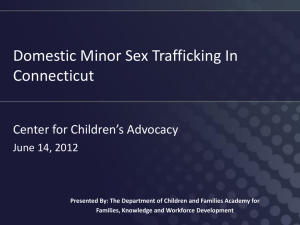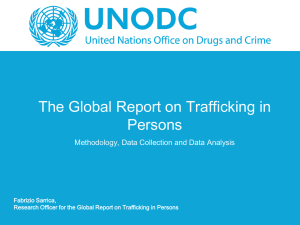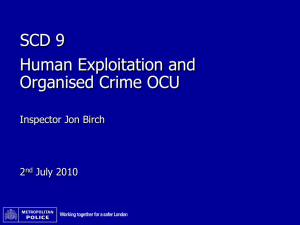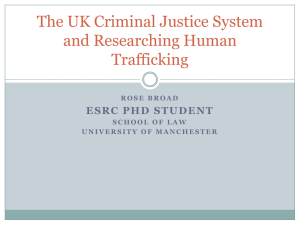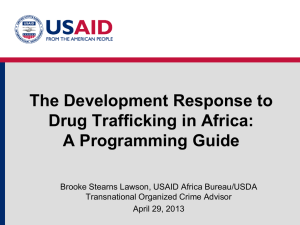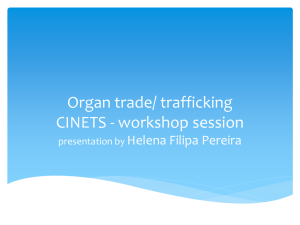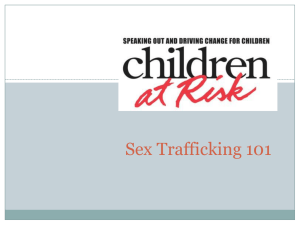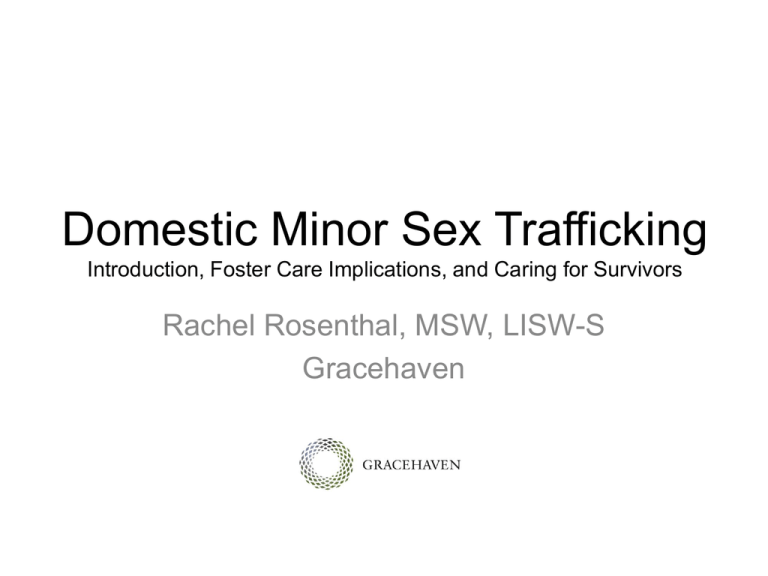
Domestic Minor Sex Trafficking
Introduction, Foster Care Implications, and Caring for Survivors
Rachel Rosenthal, MSW, LISW-S
Gracehaven
These Numbers Have Faces...
‣
‣
‣
‣
‣
‣
‣
‣
From Northern Ohio
Age 15
Sexually molested by mom’s boyfriend for 3 years
beginning at age 8
Sexually assaulted by a neighbor at 13
Began to run away at 14
Met a man who allowed her to stay with him and
provided her with food and a cell phone - began to sell
her for sex.
Traded/sold her to a trucker who sold her for sex at
truck stops from Ohio to South Carolina
Traded/sold her to a man in South Carolina where she
was sold on the internet for sex until she was turned in
by a “client” to the police
Human Trafficking Defined
‣ Human trafficking is any form of extreme exploitation of
one human being used by another for financial gain
‣ Exploited for:
‣ Commercial sex
‣ Labor
‣ Human Organs
‣ Child Soldiers
Traffickers use
force, fraud and/or
coercion to enslave
their victims in
situations involving
sexual exploitation or
forced labor.
‣ Latest estimates vary; conservative figures say between
21 and 29 million people worldwide are currently trapped
in work that they did not choose and/or cannot leave.
Domestic Minor Sex Trafficking
‣ Domestic Minor Sex
Trafficking:
‣ When a U.S. citizen or legal
permanent resident who has
not attained 18 years of age
is engaged in a commercial
sex act.1
1 Trafficking
Victims Protection Act (TVPA) of 2000
Domestic Minor Sex Trafficking
‣ “Commercial sex act”
includes:
‣ Prostitution
‣ Exotic
dancing/stripping
‣ Pornography
1TVPA
of 2000, reauthorized most recently in 2013
Domestic Minor Sex Trafficking
‣ “Commercial sex act”
‣ A sex act on account of
‣
which anything of value is
given to or received by any
person.
Value:
‣ Money
‣ Food
‣ Drugs
‣ Shelter
‣ Higher Status in a Gang
National Statistics
‣
FBI
‣100,000 - 300,000 victims nationally annually1
‣“Operation Cross Country VII”- a series of nationwide sweeps targeting
criminals involved in trafficking American children into prostitution (July 2013:
More than 100 children were rescued; 150 pimps arrested)
‣To date 2,700 children have been recovered from prostitution through the
FBI’s Innocence Lost Task Force
‣
U.S. Dept of Justice
‣Estimates the average age of entry to be 12-14 years old
‣Approximately 80% of human trafficking victims are women and girls and up
to 30% are minors. U.S. State Department
1
Ernie Allen, Director, the National Center for Missing and Exploited Children, July 19, 2010, Human Trafficking Caucus, U.S. House of
Representatives
Trafficking in Ohio
‣Most recent report issued by the
Ohio Commission to Study
Human Trafficking (2012)
‣1078 victims of DMST in Ohio
‣Over 3000 children are
considered to be “at-risk” for
trafficking
‣Toledo has the 3rd highest
incidence rate of DMST in the US
Why Ohio?
‣ International borders close by
‣ Large immigrant populations
‣ Extensive highway systems (2 hour escape window)
‣ Large number of truck stops
‣ 5th leading state for the number of strip clubs
‣ 24% of children are in poverty in Ohio1
1
http://datacenter.kidscount.org/data/acrossstates/Rankings.aspx?ind=43
Trafficking in Ohio
Robin Newell:
‣Cadiz, OH (Harrison Co) Eastern
OH
‣Arrested August 2010
‣Prostituting 3 school age children
‣Took them to the “Johns”
‣Covered at least 3 counties
Pathways Into Sex Trafficking
‣
Guerrilla Pimp
‣
Either kidnaps victims or tricks
victims into coming with him
‣
Uses brutal force and threats to
control her
‣
Story of Deric Willoughby, Toledo
‣ 14 and 15 y/o cousins walking
home from fast-food restaurant
were grabbed and shoved into car
and held behind a locked and iron
barred door forced to prostitute.
Pathways Into Sex Trafficking
‣ Finesse/boyfriend Pimp
‣
Acts like a boyfriend
‣
Treats her like she’s very
special during grooming process
‣
Buys them gifts
‣
Traps them in the relationship
‣
“Investment” in money spent
Recruitment: Initial Seduction
‣ Telling the girl:
‣
‣
‣
How beautiful she is
‣
How much he likes/loves her
Giving gifts:
‣
Jewelry
‣
Clothing
‣
Cell Phone
Locations:
‣
Malls, bus-stops, drop-in
centers /shelters, parks and
social media/internet
Pathways Into Sex Trafficking
‣
Female “Friend”
‣ A female that could be
‣
‣
previously known or
unknown who is working
for (often also being sold) a
pimp
Will slowly introduce a girl
to “the life” (shopping, cars,
cell phones, nails, drugs
and alcohol)
Over 50% of girls surveyed
within Ohio who were
victims of sex-trafficking
were recruited by another
female
Trafficked by Another Female
‣
October 2012: Cleveland, Ohio
‣ Pearline Richardson
‣
‣
sentenced to 11 years for
trafficking.
One victim was 16 years old,
and was told by Richardson,
“You need to straighten your
face, the clients don’t care”,
and “You don’t matter—money
matters”.
Richardson had intended to
take her and the other women
she was trafficking to Florida
to sell them around military
bases.
Pathways Into Sex Trafficking
‣ Family Members
‣
Mothers, Grandmothers
‣
Fathers, Stepfathers
‣
Other family members
‣
Sold out of the home at times
‣
Often connected to drug
addiction
Pathways Into Sex Trafficking
‣
‣
‣
‣
‣
‣
Shaniya Davis, age 5.
Mother Antoinette Nicole Davis sold her to
Mario Andrette McNeill for sexual slavery to
pay off a drug debt.
Shaniya was found raped and dead on the
side of a road in Fayetteville, North Carolina.
Arrest warrants stated that Davis“knowingly
provided Shaniya with the intent that she be
held in sexual servitude" and "did permit an
act of prostitution with Shaniya.”
Davis was sentenced in October 2013 for 17
years in prison for second-degree murder,
human trafficking, first-degree kidnapping,
first-degree sex offense, felony child abuse
with prostitution, child abuse involving a sex
act, sexual servitude with child victim, and
conspiracy to commit sex offense against a
child.
McNeill was sentenced in May 2013 to death
for first-degree murder of Shaniya, and was
also found guilty of human trafficking with
child victim, sexual servitude with child victim,
sex offense of a child, and indecent liberties
with a child.
Pathways Into Sex Trafficking
‣
Jacqueline Toro-Williams.
‣
A 37-year-old Ohio woman from Akron was
charged with prostituting her underage
daughter in 2012.
‣
According to Akron Police Captain Dan
Zampelli, the woman was charged with
compelling and promoting prostitution in
incidents that involved her daughter, who was
11 and 12 years old at the time.
‣
The woman allegedly drove her daughter to
different apartment complexes in their
neighborhood and forced her to engage in
sexual activities with men in exchange for
money and drugs. The activity went on for at
least a year or more, mostly in 2007.
Pimp Control
‣
Pimps are masters of the art of seduction; they are able to identify the
vulnerabilities of a specific child and exploit them.
‣
‣
Once seduced, pimps use torture tactics to control their victims.
‣
‣
These behaviors include both physical and psychological torture.
Such tactics consistently lead to complete obedience and a breakdown of
personal agency and autonomy.
Pimps use the increased glamorization of pimp/ho culture, as well as cultural
acceptance of demand for child victims, to help maintain control of the child.
Pimp Control
‣
Pimp interview, “A pimp is selling girls the dream. I will tell you
whatever it takes to get what I need out of you....F**k the head,
the body is going to follow.”
‣
Detective Byron Fassett (Dallas Model) “When I arrest their pimp
there are tears - not of joy, but of sadness - the amount of control
is indescribable. The girl is left with a simple message of, ‘I own
you.’”
‣
“The pimp cuts a girl off from her friends, and family. This is all
too easy in many cases where a girl has been violated and
victimized at home. He makes her believe that he has her back,
and he alone loves her, and when that is accomplished he brings
out the weapons of violence, fear, degradation, and drugs.” Somebody’s Daughter (Julian Sher)
Vulnerability Factors
‣ History of involvement with
Child Protective Services
‣ Runaways without familial
‣
Living in a group/foster home
‣
Involvement with law
enforcement/juvenile justice
system
‣
Older boyfriend/significant other
‣
Single parent families
‣
1-2 parents in jail
‣
Self–mutilation
‣
Rape victim
‣
Use alcohol/drugs
support
‣ Failing in school/dropping out
of school
‣ Family member in the sex trade
(selling and purchasing)
‣ Friends involved in the sex
trade (selling and purchasing)
‣ Parents who use drugs
‣ History of sexual abuse
(The National Report on DMST, Shared Hope)
Runaways
‣ As many as 1.68 million children run away each year in the US. Within 48 hours of
‣
‣
‣
hitting the streets, one-third of these children are lured or recruited into the
underground world of prostitution and pornography - The National Center for Missing
and Exploited Children
Survival Sex
Typically running for a reason - Isolation, break-down of support network
Victims of DMST are disproportionately arrested and prosecuted for being
“Unruly”
Under Ohio law, a minor who is: 1) habitually truant from school; 2) persistently
disobedient (including behavior such as running away from home; 3) who acts in a
way that injures or endangers another's (or his or her own) health or morals; or who
violates a law that applies only to minors (such as a curfew).
Indicators
‣
‣
‣
‣
‣
‣
‣
‣
Hotel room keys
‣ Restricted/scripted communication
Chronic runaway/homeless youth
‣ Inconsistencies in story
School Truancy / Drop-out
‣ Lack of knowledge of a given
Signs of branding (tattoo, jewelry)
community/whereabouts
Lying about age/false identification
‣ Having new / trendy nails, clothes, hair,
technology
Presence of an overly controlling and
abusive “boyfriend”
Injuries/signs of physical abuse or
torture
Demeanor – fear, anxiety, depression,
submissive, tense, nervous
‣ Weight loss
‣ Substance Abuse
‣ Needing pregnancy tests frequently
‣ Recurring sexually transmitted infections
The Girls I Work With
‣ Have Trauma Bonds
‣
Trauma Bonds – both loving and hating your abuser. When the very
person who can rescue you is the person who is abusing you.
‣
Trauma bonds were typically first formed with the abusive parent. So to
relate this way is not an unusual experience.
‣
Symptoms: Inability to self-identify as a victim; returning to the
trafficker/pimp, loss of the victim’s identity.
‣
“Central to understanding ambivalence is the fact that the very thing
that was despised also brought some degree of pleasure.” (Allender)
Questions to Ask When You Suspect DMST
(or Any Trafficking Victimization)
‣ How old is your boyfriend?
‣ How did you meet your
‣
‣
‣
‣
‣
‣
boyfriend?
Do you have any friends that
“exchange favors” with
neighbors / friends?
Can you come and go as you
please?
Have you ever been hurt or
threatened if you tried to leave?
Where do you eat and sleep?
Do you and your parent /
guardian “exchange favors?”
Who lives in your home?
If you suspect DMST...
‣ Central Ohio Rescue & Restore Coalition:
‣ (614) 285-4357 (HELP)
‣ This hotline will help you:
‣ Identify local community resources to help victims
‣ Determine if you have encountered victims of human trafficking
‣ Coordinate with local social service organizations to help protect and serve victims
so they begin process of restoring their lives
‣ Rachel Rosenthal, MSW, LISW-S: rrosenthal@gracehaven.me/614.886.7014
‣ Bethany Barney, MSW, LISW: bbarney@gracehaven.me /614.886.7019
Helping Victims of DMST
‣
Drawing on your new understanding of what makes
youth vulnerable, particularly Children Services
involvement, child abuse/neglect, and foster care/group
home care, we will now transition to discussion of the
trauma of DMST and how to create a safe environment
in which youth can process, recover, and grow.
Understanding What is Going On
Inside The Brain of The Traumatized
Child
Parts of the Brain
Where Trauma is Experienced in
the Brain
•“Neuroscience has confirmed that trauma is experienced
in the midbrain, where reason and logic – the ability to
make sense of what has happened and act accordingly –
simply are not accessible in trauma…
Another way to explain how trauma is not primarily a
cognitive experience is to examine memory processes,
specifically the differences between explicit and implicit
memory processes.” (Steele and Kuban, 2013)
Explicit Memory
• Also called “declarative memory”
• Refers to primary cognitive processes in the
neocortex region or the upper brain, also
referred to as the left hemisphere.
• We have access to language
• Words to describe what we are thinking &
feeling
• Allows us to process information
• Reason
• Make sense of experiences
Implicit Memory
• HOWEVER, TRAUMA IS EXPERIENCED IN
IMPLICT MEMORY OR THE MIDBRAIN OR
RIGHT HEMISPHERE
• Implicit Memory
– No words to accurately describe or communicate what is being experienced
– Changes in Broca’s area of brain which leads to difficulties identifying and
verbalizing experiences
– Traumatic experiences are stored through the senses – what we see, hear,
smell, touch, and taste
DMST & Trauma
Traumatic Elements of DMST:
•Psychological Control
•Verbal & Emotional Abuse
•Physical Abuse/Violence
•False perception and
demonstration of “love”
•Sexual Abuse
•Manipulation
•Dependence on trafficker (read:
Trauma Bonding)
•Deprivation of self-agency
•Confusion of trustworthiness
•Isolation: Both physical and
relational
•The harm and abuse they suffer is at
the hands of someone in whom they
should be able to trust and on whom
they are dependent for survival.
Recall the frequency of abuse and victimization PRIOR to
trafficking recruitment!!!
Post-Trauma Symptoms
• Mood/Affect:
– Depression, anxiety
– Blunted response
– Labile affect, especially in
story telling
• Attachment Difficulties
– Dependence on others
– Distrust of characters who
trigger memories of
trafficker
– Distrust of other women
(competition engineered by
trafficker)
•
•
•
•
Re-experiencing
Hypervigilance
Self-harm
Emotional regulation
difficulty
• Psychotic symptoms
(dissociation)
• Panic triggered by people,
places, objects, etc. that
represent elements of the
trafficking experience.
Post-Trauma Symptoms, cont.
• Behavioral responses to meet emotional safety
needs can often be interpreted as “acting out” or
“manipulation”. Some are even called
“borderline” symptoms.
•Lying
•Exaggerated or blunted
emotional responses
•Self-harm
•Suicidal ideation/gesturing
•AWOLing/running away
•Violent behaviors (fighting,
verbal aggression
•Sexually inappropriate
behaviors/risk behaviors in
relationships
•Etc.
REMEMBER!
All behavior has a purpose!
A Formula For Perspective
Self-destructive (to us)=self-PROTECTIVE (to them)
In the Past?!?!
“The past is never dead.
It’s not even past.”
-William Faulkner, Requiem for a
Nun
Special Considerations
What Makes Trafficking Trauma Unique?
Poor Insight:
Because of the deception and seduction
inherent in the recruitment process, victims
often do not immediately consider their
experience to be exploitation, and thus often
do not self-identify as victims.
More Special Considerations
• The “Ownership” Factor
• Chronic (long-term and
repeated) trauma
• Many perpetrators, not
just one
• Loss of identity
• Often not treated as
victims
• The Double Bind of
Trauma Bonding:
– The person harming her is
the only one who can save
her.
– Having strong feelings for
the person who is
victimizing her.
– Worrying for the wellbeing
of a person who did not
have any concern for hers.
Common Needs: Practical
• Healthcare
– Often with emphasis on sexual/reproductive
health: STDs/STIs, pregnancy,etc.
– Injuries from physical abuse often left
untreated.
• Education
• Independent Living Skills
• Housing
More Common Practical Needs
•
•
•
•
•
•
Food/Clothing
Legal Assistance
Transportation
Child Care
Financial assistance
Money management skills
Common Needs: Therapeutic
• Trauma-focused therapy
• AOD treatment
• Relational skills recovery
– (read: BOUNDARIES)
• Comprehensive case management
– Integration of meeting practical needs and
therapeutic needs; advocacy
The Most Important Need: SAFETY
• Safety=Freedom
–Freedom from physical and emotional assault (and the
threat thereof)
–Freedom from control
–Freedom from judgment (of experiences, emotions,
behavior, etc).
–Freedom to process emotions & begin to rebuild
–Freedom to have and hold on to hope that recovery is
possible and within reach
Meeting Needs: Service
Provision
• Wraparound services are essential, whether the victim is
being maintained in a residential or community
environment of care.
– Integration of practical needs and therapeutic support.
– Combining the skills and resources of multiple collaborating
professionals provides “one-stop shopping” for the client and
avoids the common assessment challenge of the client being
retraumatized by being asked to provide the same narrative
many times.
Trauma-Focused Therapy
• Efficacy is dependent on client insight, readiness
for participation
• Modalities & Interventions:
–
–
–
–
Trauma-Focused Cognitive Behavioral Therapy
EMDR
Structured Sensory Intervention (TLC Model)
Guided Imagery & Relaxation Techniques
• Promote client safety and minimize retraumatization risk
When Home is Not Safe…
• Residential treatment
– Most effective when program is build specifically for
survivors of commercial sexual exploitation
– Peer support (“survivor leadership”)
– Holistic care: physical, mental, emotional, relational,
spiritual
– Longer than typical behavioral residential programs
When Home is Not Safe…
• Foster Care
– Must provide the same recovery components
and securities that make residential treatment
for victims effective.
– Caregivers trained specifically in trafficking
and commercial sexual exploitation.
– *SAFETY AND SECURITY* are as critical in
the emotional realm as they are in the
physical realm.
Common Risks in the Process
• Challenged Insight
– What to “call” their experience
– Depth of impact of victimization
– Danger of continued victimization
– Mental Health symptoms
– Who is safe and who is unsafe
Common Risks in the Process
• AWOL/Running Away
– Back to trafficker/other unsafe people (recall
the seduction/force cycle of recruitment, and
attachment)
– Similarity to DV/IPV cycle
– Unaccustomed to rules and structure (and
there is no environment for youth outside of
juvenile detention that is more structured than
foster care!)
Common Risks in the Process
• Mental Health Symptoms
– Participation in treatment is critical; however,
rehearsing history can be overwhelming to the
emotions.
– Overwhelming emotions (depression, anxiety,
fear, paranoia) can influence impulsive
behaviors
– Impulsive behaviors can appear selfdestructive (again, read: self-protective)
Common Risks in the Process
• Relational Struggles
– Distrust of others
– Few/no strong or helpful relationships
– Warped perception of safety increases AWOL
risk
• (Either that they are not safe with their caregiver or
that they are not in danger if they go out on their
own)
Dr. Herman’s Stages of
Recovery
• Applicable to widely varying sources of
trauma and environments of care
• Can be worked through in individual or group
settings, and must be supported at home
• Undergirded throughout by the “Healing
Relationship”, wherein caregiver maintains
the safety of the therapeutic environment and
facilitates survivor’s efforts and success
Dr. Herman’s Stages of
Recovery
• Stage 1: Safety
– Survivor reclaims control over self
– Definition/parameters of safety are holistically
defined as previously discussed
– No concrete “graduation” or “completion date”
for this stage
Dr. Herman’s Stages of
Recovery
• Stage 2: Remembrance and Mourning
– Acknowledgment of the factual nature of the
story of the trauma
– Addresses emotional component of memories
– Acknowledges loss attributable to the trauma
and receives permission to mourn
– It is critical in this process for the caregiver to
provide a supportive environment for grieving
to take place.
Dr. Herman’s Stages of
Recovery
• Stage 3: Reconnection
– Self
– Others
– “Survivor Mission”: Forward Motion
ARC Framework
• Blaustein & Kinniburgh, 2010
– Resiliency focused
– Emphasizes treatment and support to restore
the primary three realms of functioning that
are damaged by the experience of trauma
– Engages the critical role of the caregiver at
each stage
ARC Framework
• Stage 1: Attachment
– Relationship restoration
– Consistency in interaction with the child is
stressed via:
•
•
•
•
Caregiver Management of Affect
Attunement
Consistent Caregiver Response
Building Routines and Rituals
ARC Framework
• Stage 2: Self-Regulation
– Builds the child’s ability to manage self by
increasing self-awareness and restoring skills
• Affect Identification
• Modulation
• Affect Expression
ARC Framework
• Stage 3: Competency
– Increasing the fluent exercise of emotional
regulation
• Strengthening Executive Functions
• Self-Development and Identity
Communicating With the
Traumatized Child
This child is working from her implicit
memory. This means she has been
triggered & is somewhere in her
midbrain. Adult: Come out from your
room! Child: NO! Adult: You will have
consequences if you do not come out
from your room, it’s time for dinner!
Child: I hate you, get away from me!
Adult: That’s it, you are getting
punished, this behavior is
unacceptable, you are making bad
choices and treating me poorly.
Communicating With the
Traumatized Child
This child is triggered & working from
their implicit memory, their mid brain.
Adult: Why are you on the floor in
your room? Child: No response.
Adult? What are you smelling right
now? What are you seeing right now?
Do you hear anything right now? Do
you know who I am right now?
Child: I smell the same cologne from
when he hurt me. Adult: You are safe
right now. There is no one else here.
Some visitor came by but he is gone
now and I will make sure nothing
happens to you. Is it OK if I hug you?
Do you want to be touched? Or do
you want your special blanket?
Tips for the Clinician
•
Match the individual’s way of identifying others (i.e., do not identify the perp
as the “trafficker” if she calls him her “boyfriend”)
•
Meet the client where they are. Motivational interviewing is your best friend.
•
Just like with any trauma survivor, do not force a victim to repeatedly
rehearse the narrative of their trauma. Some selected risks of this are:
–
–
–
–
•
Psychological/emotional
Legal
Social
Etc.
Feel free to use local agency resources or the CORRC hotline if you work
with a youth that you suspect may be a trafficking victim.
Helpful Resources
• For much of the information contained herein I am deeply indebted
to the following resources and publications:
– National Child Traumatic Stress Network
• www.nctsn.org
– Shared Hope International
• www.sharedhope.org
– Trauma and Recovery, by Judith Herman, MD (2nd ed., 1997, Basic
Books)
– Treating Traumatic Stress in Children and Adolescents, by Margaret
Blaustein and Kristine Kinniburgh (2010, The Guilford Press)
– National Colloquium 2012 Final Report: An Inventory and Evaluation of
the Current Shelter and Services Response to Domestic Minor Sex
Trafficking
– US Department of Health and Human Services
– The National Institute for Trauma and Loss in Children (TLC)
• www.tlcinstitute.org



